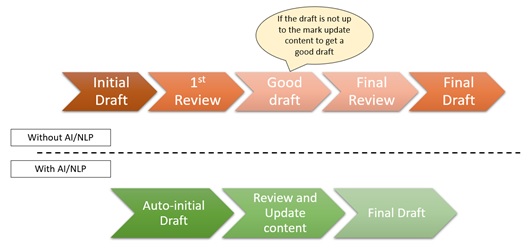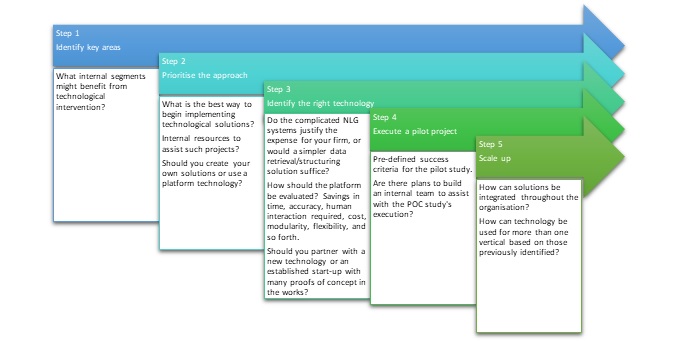Regulatory medical writing is a highly complex task and requires expertise. There are various challenges that medical writers face every day while creating documents required for submissions to competent Health Authorities (HAs). One of the major challenges here is the time required for the entire medical writing process, from the first draft to the final submissions-ready draft. If some of the steps in this process are automated, it will save medical writers a lot of time and reduce the turnaround time. Medical Writing Automation (MWA) will help ease the task of medical writers. However, the lack of awareness of how automation and medical writers’ expertise go hand in hand to make medical writing tasks more productive is a huge challenge that must be overcome. This article decodes how automation is a boon for the medical writing industry and how various companies are proactively trying to adopt automation in medical writing.
The Pharmaceutical and Life Sciences industry has seen a constant growth in the need for medical writing. The global medical writing market was valued at US$3.6 billion in 2021 and is expected to reach US$8.4 billion in 2030, growing at a Compound Annual Growth Rate (CAGR) of 10.41 per cent. Patents have been expiring, Regulatory standards have been rapidly changing, and Research and Development (R&D) expenditure has been steadily rising. Because of this, the necessity to continuously adapt, produce, maintain, and update medical materials has evolved.
Medical writing is a highly specialised field that involves the art and science of content creation and clinical research. It entails creating well-structured scientific resources, such as clinical research papers, web content for the Healthcare industry, periodicals, journals, etc. With the increasing need for medical writing, writers are under constant pressure to deliver high-quality content within limited timeframes. It would be easy for medical writers if some steps of the process were cut down with automation tools.
The Medical Writing industry has been trying to stay at par with the revolution in the industry and the shift towards automation by adopting innovative and intelligent solutions that will ease the process of Regulatory writing, thereby ensuring a quick turnaround time.
Complexities and Challenges in Medical Writing
Medical writing is a highly technical and operationally difficult process involving a broad range of stakeholders and deep subject-matter expertise. The creation of several crucial papers, such as clinical trial protocols, investigators’ brochures, clinical and non-clinical study reports, summary documents, and labeling documents, is a crucial component of medical writing during clinical or R&D phases. The following are some of the challenges that medical writing professionals face:
Medical Writing Automation (MWA)
MWA is a framework that generates content using Natural Language Processing (NLP) and Natural Language Generation (NLG) techniques and algorithms. Artificial Intelligence (AI) has made significant advances in text generation, processing, and data mining. AI-powered engines used in these services may comprehend the context and recommend the relevant terminology. The technology is also useful when developing user-friendly content. A computer, when correctly programmed, shows no bias. It makes forecasts and suggestions based on its training. Medical writers can benefit from computer innovation and the advent of AI in the domains of NLP and NLG when creating medical documentation.
The MWA Process
NLP is a five (05)-step process that begins with identifying and analysing the structure of words, checking the grammar, arranging words meaningfully, drawing the exact dictionary meaning of words, comparing the meaning of a sentence to the sentence preceding it, and finally, reinterpreting the actual meaning of a sentence. NLG produces meaningful phrases and sentences in natural language from some internal interactions between human language and computers. It involves text planning, sentence planning, and text realisation.
AI, combined with NLP and NLG, automatically extracts information from a wide range of data sets, whether structured or unstructured. The extracted data is subsequently analysed to interpret and categorise the substance and context of the information, and the content and context data are stored in a dynamic semantic model. The diagram below (Figure 1) depicts how NLP and NLG aid the medical writing process, making it more efficient.
Figure 1: NLP and NLG Assisting in the Medical Writing Process

Source: Created by Author
The process described above modifies the information and context of the material when it needs to be reused or repurposed to suit the needs of diverse stakeholders in the life sciences ecosystem. The solution maintains a data set that is easily searchable using Natural Language queries. Additionally, impact analysis is performed to improve change management whenever any new or updated content is made public.
MWA is especially useful for repetitive activities with a high level of redundancy. Most of the time and effort devoted to developing these documents is spent acquiring data from pre-existing sources (such as study procedures, figures, tables, and statistical analyses) and organising them under appropriate section headings. The figure below (Figure 2) explains how the AI/NLP solution can reduce 50–80 per cent of the time, as compared to the traditional approach.
Figure 2: The Traditional Approach of Medical Writing Vs. Adopting the AI/NLP Solution for Medical Writing

Source: Created by Author
After the automated process, as described above, is done, the medical writer’s input would now be valuable in refining the finished article and putting forward an expert scientific interpretation. It can also expedite submissions and marketing authorisations by producing complex documents in a fraction of the time the process usually takes days rather than weeks, which saves costs. The capabilities of MWA are growing every day, and it may now be used to create documents that require a higher level of editorial expertise, such as peer-reviewed articles, abstracts, and posters.
Adoption of Automation in Medical Writing
Well, this topic is up for debate between medical writing service providers, on the one hand, and medical writers, on the other. Some companies have started pilot studies on the use of automation in medical writing. The results of the studies carried out by various companies mention that automation is going to be beneficial for medical writers; it will save up to 80 per cent of their time and can process and manipulate a large quantity of data in only a few minutes. When it comes to automation, businesses are adopting a two (02)-pronged strategy. They are either building internal automation capabilities for quality control, data structure, analysis, and document generation, among other things, or liaising with organisations that offer automation tools and platforms, either by acquiring these companies or by using the tool or platform developed by the companies. In the figure below (Figure 3), some steps are mentioned, which should be followed while selecting a medical writing tool for your company:
Figure 3: Steps for Selecting a Medical Writing Tool for Your Company

Source: Created by Author
However, medical writers are skeptical about adopting these technologies; they have heard that AI can produce reports from scratch in only a few minutes, which sounds like a job-elimination program to some! The truth is that the output from AI will be a first copy that pulls together content from source papers and source data. It will put all the components in place, leading up to the truly intellectually stimulating portion of medical writing, which is working with the authoring team to design the storyline and polish the messaging. It is precisely this intellectual input that no AI tool can provide, which indicates that competent medical writers will continue to be in demand even with the full-stream adoption of AI in the medical writing field.
The adoption of MWA remains a question mark. Companies are eagerly exploring how they can adopt this technology, which can help them save a lot of time and enable medical writers to complete their work faster. Therefore, for a smoother adoption of MWA by organisations, it is crucial to create awareness among medical writers about the beneficial role of AI and how it complements their work, making them more productive.
The Future of MWA
With all the buzz that is going around on AI and Machine Learning (ML) and a major shift from traditional approaches toward using tools and technologies to make lives easier, the transition to automation will occur very soon. Medical writers will soon align with the importance of using automation, which will not only ease the process and cut down some of the steps involved in the traditional medical writing method but will also ensure that the writers are not completely replaced. Moreover, companies are proactively trying to find ways to adopt automation, be it internally by developing tools or bots or externally by liaising with some other company that has a similar tool or platform. Hence, the only way forward is to accept the fact that automation is the need of the hour and to get aligned with it as soon as possible.